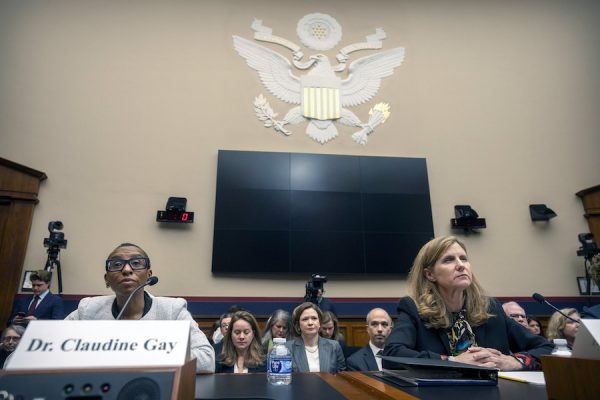Decades of legal gains for LGBTQ people are on the brink of being reversed. Texas governor Greg Abbott recently issued an executive order declaring that gender-affirming care for minors constitutes child abuse and directed social service agencies to commence investigations. After several investigations had started, a Texas state court issued an injunction temporarily halting those inquiries, but the future remains uncertain. Arizona just passed a similar law banning gender-affirming care for children. Meanwhile, not to be outdone, Florida enacted what opponents call a “Don’t Say Gay” bill banning the discussion of sexual orientation and gender identity in grades K–3. Taking a page from Texas’s recent anti-abortion law, the law also affords parents greater opportunity to take legal action against school districts that they think violated the law.
That’s just the start of it. The Supreme Court may overturn Roe v. Wade when it hands down its forthcoming decision in Dobbs v. Jackson Women’s Health Organization. Ominously, Texas Right to Life advised in its Dobbs amicus brief that the Court should not “hesitate to write an opinion that leaves” decisions such as 2003’s Lawrence v. Texas (which overturned bans on consensual sexual relations between same-sex adults in private, the so-called anti-sodomy statutes) and 2015’s Obergefell v. Hodges (which legalized gay marriage) “hanging by a thread” because they “are as lawless as Roe.” The days of Lawrence and Obergefell—and more recently Bostock v. Clayton County, which ruled against firing someone based on their sexual orientation or gender identity—may be numbered.
At first blush, the legal peril in which LGBTQ people find themselves might seem to confirm the worst fears expressed by progressive critics of legal strategies in movements for social justice. Rights can be granted, such critics emphasize, but rights can also be taken away. According to this line of thought, progressive social movements would be better off putting their energy elsewhere; relying on the state to validate claims constrains the possibility of radical social change. Others hold more tempered views, acknowledging that legal strategies can spur activism even when they fail to achieve stated goals. According to this view, law and social movements are mutually constitutive, but legal mobilization does not go far enough in understanding the relationship between law and society.
Today, as LGBTQ and other legal protections hang in the balance, we ought to move beyond the narrow question of the generic benefit or harm of legal strategies. We need a broader focus, in particular, on the interplay among law, social movements, and institutions. Rather than view the law in isolation from the rest of society, we must recognize that law has a complex relationship with other social and cultural institutions and that legal strategies do not represent the totality of social movement activism.
This essay is featured in Rethinking Law.
Indeed, the law is inextricably linked to systems of cultural meaning—systems comprised of what sociologist Ann Swidler has called a “cultural toolkit” consisting of narratives, images, and discourse that help to make sense of the world. In the case of sexual orientation and gender identity, an overlapping network of institutions—religion, psychiatry, and the law itself—has been particularly powerful in shaping the lives of LGBTQ people, having variously defined them as sinners, disordered, or criminals. Even where they have been marked by internal disagreement over priorities, LGBTQ social movements have had great success over the last few decades in challenging these institutional configurations.
What does this mean for LGBTQ people today? The bevy of new legislative efforts by the right looks, in effect, like an attempt to pretend, if not quite pray, the gay and trans away. In an ironic display of the so-called cancel culture that they claim to oppose, Republicans are intent on disappearing LGBTQ people under the guise of protecting children—never mind that many of these children may be queer themselves or have queer parents, relatives, and friends. Legal advances won in recent years may be at risk not because of bigotry toward LGBTQ people, but because of electoral advantages that reward a vocal minority of right-wing politicians. These same politicians strategically wield anti-LGBTQ proposals as wedge issues to propel social conservatives—especially white evangelicals—to the polls. Any analysis of the relationship between the law and progressive social movements must take such structural power into account, but it must also contend with the complex, dialectical interplay between legal and social change.
An important case study is the history of the fight for same-sex marriage. Though activists have long debated the role that marriage equality should play—some view it as oppressive in its own right, while others argue it is simply not the most important issue facing LGBTQ communities—large swaths of LGBTQ people mobilized to achieve same-sex marriage. Skeptics note that focusing on the legal demand for marriage recognition diverted time, resources, and energy away from broader social and political change, constricted political imagination, or even defused more radical transformation. But legal strategies are only one part of the broader LGBTQ movement. Underlying the marriage equality victory were decades of organized and individual struggles—sometimes unified, sometimes at odds—to gain social, economic, and legal support for LGBTQ people and their families. These efforts created widespread institutional change that will be hard to undo, even as their precise significance and implications continue to be debated within the LGBTQ community.
To take one example, employee resource groups placed pressure on corporate employers to advocate for same-sex marriage. While corporations had their own interests, such as streamlining how they distribute benefits, such groups contributed to changing corporate policies. Many Fortune 500 companies, for example, enacted domestic partner policies before same-sex marriage was legally recognized by the state. This pressure came from both inside and outside. Employee resource groups pushed companies to change their policies, and outside groups such as the Human Rights Campaign began to rank companies based on their Corporate Equality Index. Still more radical groups such as ACT UP threatened to protest companies they deemed homophobic, enabling the employee groups, which looked tamer by comparison, to exert greater leverage.
One significant result of this activism came in 2015, when a group called 379 Employers and Organizations Representing Employers, including Fortune 100 companies and small businesses, filed an amicus brief in Obergefell supporting marriage equality. A coalition of large labor unions including the AFL-CIO, Change to Win, and the National Education Association together representing nearly 20 million workers also filed an amicus brief in favor of marriage equality, the outcome of internal pressure for change. While religious opposition to same-sex marriage continues, especially among Catholic and evangelical organizations, there were also three different briefs submitted by other religious groups, including Quakers and another representing an array of individual clergy, religious groups, and organizations. Finally, the American Psychological Association and the American Public Health Association along with Whitman-Walker Health each filed a brief in support of same-sex marriage.
These briefs are significant not only because of their arguments, or because of the wide range of popular support from very different social domains that they marshalled on behalf of same-sex marriage, but also because they are products of a vast network of unseen and far-reaching social movement activism. Some of this activism is largely invisible to the public, taking place slowly over decades within corporate conference rooms, as in the case of employee resource groups. Other efforts are more public, such as that of the HRC and ACT UP. The HRC continues to use reputational threat and incentives to cajole companies to adopt a greater array of LGBTQ-friendly policies and practices, such as educating employees about appropriate use of pronouns with coworkers and customers and providing gender-affirming care to employees.
Psychology and psychiatry have also wielded great power over what today we refer to as LGBTQ communities. Lesbians and gay men had once been subject to abusive efforts to “cure” them that ranged from the now discredited “conversion” or “reparative” therapy to barbaric electroshock treatments. Beginning with its first edition in 1952, homosexuality was listed as a psychiatric disorder in the Diagnostic and Statistical Manual of Mental Disorders published by the American Psychiatric Association (APA), severely impeding efforts to win equal rights and equal treatment before the law. But after decades of sustained, multi-pronged activism, the APA removed homosexuality from its list of mental disorders in 1973 and adopted resolutions deploring discrimination against “homosexuals” in housing, employment, and licensing and demanding that the government repeal anti-sodomy statutes.
This shift—a victory of social movement activism—took place outside the law, but it had a profound impact on broader cultural norms and public opinion, which in turn shaped new legal changes and protections. LGBTQ activists demanded that researchers conduct controlled studies of noninstitutionalized populations of straight and gay people rather than relying on homophobic assumptions. New studies found gay and straight groups indistinguishable from each other in blind controlled studies, upending the view that lesbians and gay men suffered from mental illness. This effort, along with protests, challenged the cultural logic and categories of an institution with great power to regulate and discipline LGBTQ people. In turn, LGBTQ activists had a new tool they could bring to bear on the state when demanding changes in laws and policies.
For example, the National Gay Task Force (now the National LGBTQ Task Force), together with the APA, the American Psychological Association, and the American Public Health Association and Health Service, all took part in lobbying the U.S. Public Health Service to change its classification of homosexuality from a mental illness in the late 1970s. The Immigration and Naturalization Service relied on the U.S. Public Health Service’s diagnosis to deny citizenship to lesbian and gay aliens. Court decisions in 1977 resulted in a new policy that no longer viewed homosexuality as an inherent index of “poor moral character.” The following year, the U.S. Public Health Service adopted the APA’s decision that homosexuality was not a pathology. While removing the equation of homosexuality with pathology that had provided a categorical barrier to citizenship for gay and lesbian people did not eliminate all obstacles for lesbian and gay immigrants, it changed the terms of the debate and marked an important cultural shift that would shape future immigration and citizenship policy.
This is just one of many examples of leveraging one institution to affect change in another. Activists continue to challenge how the APA diagnoses and handles the care of people who are transgender or have intersex traits. While support of trans children varies greatly across the country, the move has been in the general direction of providing gender-affirming care, though of course we are far from there yet. Intersex advocacy groups continue to challenge the medical community for performing medically unnecessary surgeries on infants born with intersex traits across the world.
Membership in what cultural anthropologist Gayle Rubin calls the “charmed circle” of social acceptance is always provisional, and the latest attempts to marginalize and exile LGBTQ people from full and equal citizenship are a case in point. How these efforts will play out in the short term remains to be seen, but what is clear is that to understand the current political moment for LGBTQ people, we need a more nuanced view of law’s place in society. The law is subject to its own internal logic and to the pendulum swings of electoral circumstance, but it cannot be divorced from its wider social, cultural, and institutional context.
On the one hand, this means that the law is far too often a tool of the powerful who benefit from structural inequalities. On the other hand, the embeddedness of law in society also makes it a resource for the marginalized and sensitive to the many other institutions that shape our social life. At the end of the day, profound cultural shifts and institutional changes in the United States over the last several decades will ensure that these latest efforts to legislate anti-LGBTQ prejudice remain vigorously contested at all levels of society, from the halls of formal political power to medical associations and protests organized by young people. Gay and trans people can’t and won’t be legislated away. In the meantime, we must work to oppose the harm that has already been done and is still being perpetrated by dangerous rhetoric and the laws that have already made it onto the books. Doing so will require both tactical and strategic pluralism, marshalling legal challenges and electoral mobilization as well as the rich legacy of social movement activism that LGBTQ people and their allies have to draw on.









